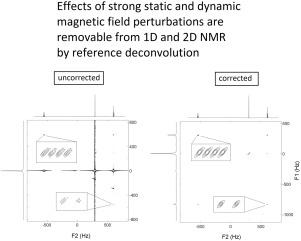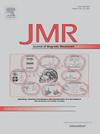Removing magnetic field noise from NMR spectra: Reference deconvolution revisited
IF 1.9
3区 化学
Q3 BIOCHEMICAL RESEARCH METHODS
引用次数: 0
Abstract
Reference deconvolution, a powerful mathematical tool for removing the effects of imperfections of the main magnetic field on NMR spectra, is revisited in the context of strong static and dynamic field perturbations. The theoretical basis and experimental evidence for the high efficiency of reference deconvolution for strong magnetic field distortions in basic liquid-state one- and two-dimensional NMR are given.
In particular, in 2D NMR, we utilise our observation that a strong static inhomogeneity of the main magnetic field suppresses anti-echo coherence transfer contributions, enabling reference deconvolution to be applied to the remaining echo contributions, in each indirect increment separately, in a manner similar to 1D NMR. We show that, in both 1D and 2D NMR, reference deconvolution enables one to remove the vibrational artefacts of cold head operation in cryogen-free magnets.
This extends the applicability of reference deconvolution in multi-dimensional NMR and advances cryogen-free technology in liquid-state NMR.

从核磁共振波谱中去除磁场噪声:参考反褶积
参考反褶积是一种强大的数学工具,用于消除主磁场缺陷对核磁共振波谱的影响,在强静态和动态场扰动的背景下重新审视。给出了对强磁场畸变进行高效参考反褶积的理论基础和实验证据。特别是,在二维核磁共振中,我们利用我们的观察,即主磁场的强静态不均匀性抑制了反回波相干转移贡献,使得参考反卷积能够以类似于一维核磁共振的方式,在每个间接增量中分别应用于剩余的回波贡献。我们表明,在一维和二维核磁共振中,参考反褶积使人们能够消除无低温磁体中冷头操作的振动伪影。这扩大了参考反褶积在多维核磁共振中的适用性,并推进了液态核磁共振的无低温技术。
本文章由计算机程序翻译,如有差异,请以英文原文为准。
求助全文
约1分钟内获得全文
求助全文
来源期刊
CiteScore
3.80
自引率
13.60%
发文量
150
审稿时长
69 days
期刊介绍:
The Journal of Magnetic Resonance presents original technical and scientific papers in all aspects of magnetic resonance, including nuclear magnetic resonance spectroscopy (NMR) of solids and liquids, electron spin/paramagnetic resonance (EPR), in vivo magnetic resonance imaging (MRI) and spectroscopy (MRS), nuclear quadrupole resonance (NQR) and magnetic resonance phenomena at nearly zero fields or in combination with optics. The Journal''s main aims include deepening the physical principles underlying all these spectroscopies, publishing significant theoretical and experimental results leading to spectral and spatial progress in these areas, and opening new MR-based applications in chemistry, biology and medicine. The Journal also seeks descriptions of novel apparatuses, new experimental protocols, and new procedures of data analysis and interpretation - including computational and quantum-mechanical methods - capable of advancing MR spectroscopy and imaging.

 求助内容:
求助内容: 应助结果提醒方式:
应助结果提醒方式:


